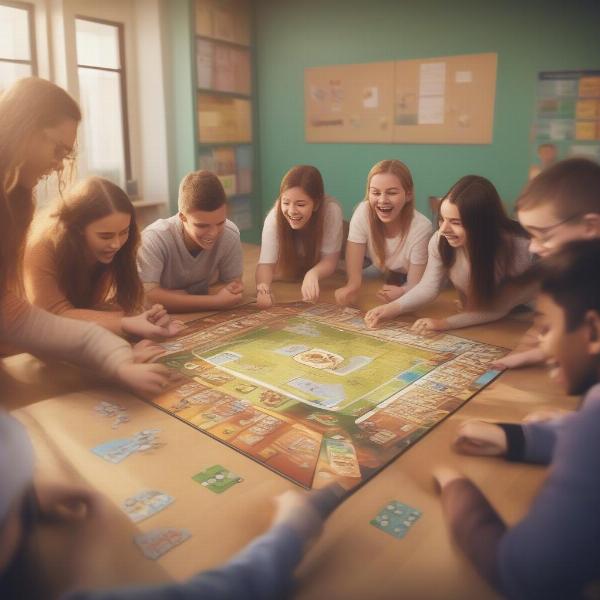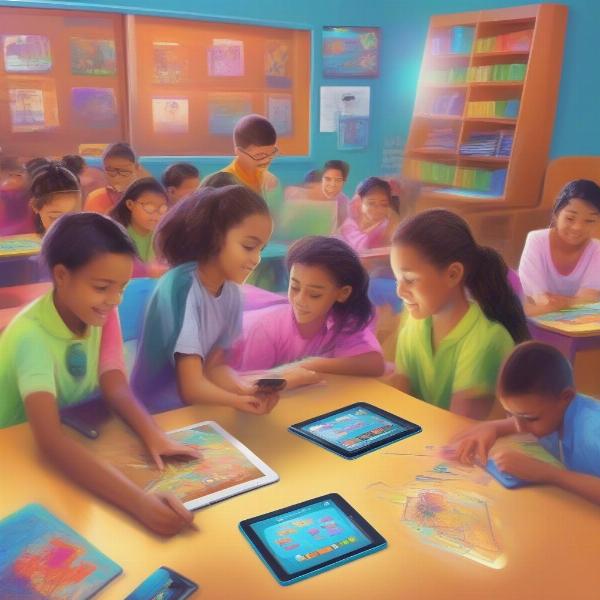Finding the best games to play in class can transform a mundane learning environment into an engaging and interactive experience. Here at Supreme Duelist Blog, we understand the power of play in education, and we are here to guide you through selecting the most appropriate and effective games for your classroom. This article will explore various game types, learning objectives, and practical considerations to ensure you are equipped to bring fun and effective learning into your lessons.
We’ll be discussing different types of games, from quick brain-teasers to more involved team-based activities, while focusing on how these can enhance learning outcomes. We will delve into the benefits of incorporating games, addressing common challenges, and providing tips for successful implementation. Let’s jump in and discover how to make your classroom a place where learning and fun go hand-in-hand.
Why Integrate Games into the Classroom?
Integrating games into the classroom isn’t just about adding a fun break; it’s a strategic move to enhance learning. Games can improve student engagement, boost memory retention, and foster critical thinking skills. When students are actively involved and enjoying the activity, they are more likely to absorb information. Furthermore, the social aspect of many classroom games can enhance teamwork, communication, and problem-solving abilities. This approach turns learning into an active, not passive, experience.
The Benefits of Gamified Learning
Gamified learning provides numerous benefits, including increased motivation. When students find learning enjoyable, they naturally become more engaged and curious. This engagement can lead to a deeper understanding of the subject matter. Team-based games also promote collaboration and mutual support. When the competitive element is introduced carefully, it can encourage students to work together to achieve a common goal, improving their social skills. The use of games can also break up the monotony of traditional lessons, offering a much-needed change of pace and a more memorable learning experience. If you’re looking for more engaging games for older gamers, you might also want to explore some of the best game prizes for adults.
 Classroom Games in Action
Classroom Games in Action
Types of Games Suitable for Classroom Use
Selecting the right type of game is crucial for classroom integration. Games can range from simple word puzzles to strategic challenges and each type has different strengths. It’s vital to choose games that align with the learning objectives and the age of your students. Below are some game types that often prove very effective.
Quick Brain Teasers
Quick brain teasers are short, engaging puzzles or problems that stimulate critical thinking and problem-solving. These can be used to kick off a lesson or to fill a few minutes before the bell rings. They require minimal setup and can be adapted to various subjects. Examples include riddles, logic puzzles, and quick math problems. This type of game helps to sharpen minds and make a smoother transition into a learning session.
Board Games and Card Games
Board games and card games are fantastic tools for collaborative learning. Many of them can be used to teach specific concepts, like strategy, math, or history, while encouraging teamwork and communication skills. These games provide structure and a sense of progression. Games can be chosen based on the subjects taught and can provide a fun way to practice skills. For example, a card game can improve math skills, while a board game might aid in teaching history or social studies. It’s not just limited to the classroom; many adults still enjoy the social aspect of games, similar to the engagement found in best computer games to play in class.
Interactive Digital Games
In today’s digital age, interactive digital games are another resource that can be used in classrooms. There are many educational apps and games available that are aligned with learning objectives for a range of topics, enhancing subjects with graphics, sounds, and interactive elements. These digital options can be highly engaging and cater to the digital literacy skills of today’s students. Some apps allow educators to monitor student progress and customize the learning experience. These games offer a modern and appealing way to learn, aligning education with the technology students often use in their personal lives.
Physical and Active Games
Physical and active games bring movement into the learning environment, which can be especially beneficial for students who learn best through kinesthetic activities. These games can range from charades and Simon Says to more elaborate scavenger hunts. They serve to get students physically active and engaged, which can help increase focus and energy levels. Movement also helps with cognitive functions and memory retention, creating a well-rounded learning experience.
 Educational Board Game close up
Educational Board Game close up
Implementing Games Effectively in the Classroom
The success of incorporating games depends on effective planning and execution. It is not enough to just introduce a game; it requires careful consideration of learning objectives, time management, and resources. Here are some key strategies for successful implementation.
Aligning Games with Learning Objectives
The games must align with the educational goals that need to be achieved. Choosing games that directly address the concepts you are teaching is crucial. For example, if you’re teaching fractions, choose a board game or card game that incorporates those skills. This direct alignment ensures that games are not just a distraction but become integral parts of the learning process. This also means selecting games that help students practice and apply what they have already learned.
Time Management and Scheduling
Time management is key. Set clear time limits for game sessions to maintain focus and avoid the games running too long or not being enough to make an impact. Integrating a game into a larger lesson plan is also essential; games should be placed strategically at times when students can benefit from the change of pace. For instance, games might work best as a mid-lesson energizer or a culminating activity.
Managing Competition and Collaboration
A balanced approach to competition and collaboration is essential. Some games lend themselves well to competition, while others are best for collaborative group work. Use games to promote both, as competition can encourage motivation, and cooperation can build teamwork and mutual support. Ensure that the emphasis is on learning and fun rather than on competition alone. It also helps to set clear guidelines and expectations for students before they start to avoid any negative outcomes.
Ensuring Inclusivity and Accessibility
It is important to consider inclusivity when selecting classroom games. Choose games that are adaptable to students with various learning styles, ensuring that all students feel comfortable and can actively participate in games. Provide game adaptations if necessary and have rules that support every student to join. This ensures that games become a positive and enriching experience for every student in the class.
 Digital Education Game on Tablet
Digital Education Game on Tablet
Addressing Potential Challenges
While integrating games has numerous benefits, it is important to be aware of potential challenges and have solutions in mind. Some common challenges include disruptive student behavior, games not aligning with educational objectives and the time it takes to set up. By being prepared for these situations, you will be able to deal with them effectively.
Managing Disruptive Behavior
Some games can over-stimulate some students leading to disruptive behavior. This can be managed by setting clear ground rules before starting any game. Ensure students understand expectations regarding respectful communication and engagement during play. If some students are more boisterous, there should be a way to manage this in an equitable way, either by making different groupings or giving specific roles to students.
Aligning Games With Learning Goals
Selecting games that are clearly aligned with learning goals can help to avoid them being considered a form of distraction. It may be that you will need to adapt existing games to incorporate specific concepts or skills that need to be taught. To ensure the games fit well in the lesson, make sure they are not chosen just for entertainment but also their educational value.
Logistics and Resource Management
Effective implementation also involves efficient resource management. Planning must involve preparation of all required materials like boards, cards, or digital devices, and making sure everything is ready to avoid time wastage. Set up games beforehand and teach the rules before starting. This careful prep ensures the games run smoothly and that the games fit into the lesson time constraints.
Expert Perspectives
Let’s hear from experts on the best practices for using games in education.
“Games are a powerful tool for learning when integrated thoughtfully,” says Dr. Emily Carter, an educational psychologist at the Institute of Child Learning. “Focus on games that engage students actively and promote critical thinking rather than just memorization.”
“Effective classroom games do not only teach subject content, they help with developing social skills.” notes Professor Jonathan Baker, a specialist in gamified learning. “The idea is to create a balanced learning experience that addresses diverse learning styles, but is fun for the students.”
“The beauty of games in education is that they are a fantastic tool for learning.” explains Sarah Miller, a curriculum design expert. “Select games that align with learning objectives, manage time effectively and ensure inclusivity so that each and every child can achieve the learning outcome.”
These insights underscore the importance of thoughtful selection and implementation. Games should be an integral part of the educational process, carefully chosen and executed to maximize learning outcomes. It’s also important to ensure games are not a distraction from the learning but support it. If you are looking for some retro ideas, you can also check out what are the best gba games for inspiration.
 Student and Teacher Playing a Game
Student and Teacher Playing a Game
Frequently Asked Questions
Here are some of the frequently asked questions about implementing games in the classroom:
What types of games are best for younger children?
For younger children, games that focus on simple rules and encourage movement, like memory games or active movement games, are usually best.
How can I use digital games in a way that still encourages interaction?
Digital games can be used in pairs or small groups, encourage discussion, and have time limits. Some games can also project onto the screen to create a collaborative learning activity.
Are games suitable for all subjects?
While not every subject needs a game, most subjects can use games to make learning more engaging. Try to tailor the type of game to the subject matter to increase learning outcomes.
How do I measure the effectiveness of games in the classroom?
Measure effectiveness through observation, student feedback, quizzes, or tests, but also look at engagement in classroom discussions and attitude to learning.
Where can I find good educational games?
Many educational resources and websites offer both free and paid educational games for all ages. Try and find games that are designed with educational goals in mind.
Conclusion
Integrating the best games to play in class can dramatically improve student engagement and learning outcomes. By carefully selecting games that align with your learning objectives, and strategically implementing them, you can create a positive and enriching educational experience. From quick brain teasers to collaborative board games and digital interactive tools, there are countless options to choose from. The crucial factor is ensuring that these games are used as part of the learning process, not a distraction, but an integral part of the lesson. Here at Supreme Duelist Blog, we’re dedicated to providing valuable insights into ways to make learning fun and effective. Remember to check out our other articles for more strategies for enhancing education through play.
Leave a Reply